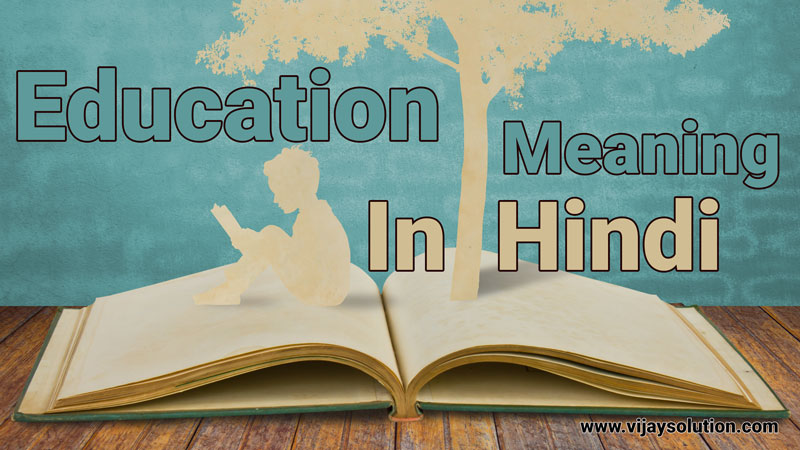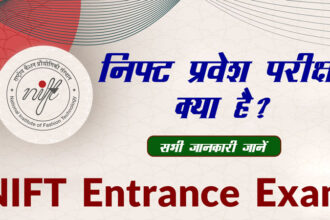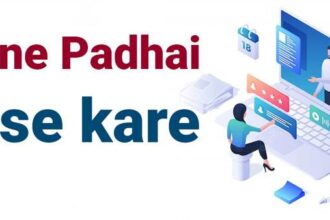Education meaning in Hindi: Learning, the development of information, talents, attitudes, ethics, beliefs, habits, and personal development supported by education. Training, teaching, conversation, storytelling, and aimed study are all examples of educational practices. So Educators are often present when learning occurs. Learners, on the other hand, can self-educate. Hence Anything that has a cause on the way one thinks behaves or feels might be called educational. Pedagogy is the phrase for the teaching method.
Education Meaning in Hindi
Education meaning in Hindi, the word education has the following meaning:
- education meaning in Hindi – शिक्षा (Shiksha)
- EDUCATION=shikSha(Noun)
- EDUCATION= PADhaI(Noun)
Following the independence of India, the central government established many schemes for the development and promotion of Hindi under Article 351 of the Constitution. Under these plans, a programme was launched to provide Hindi teaching a push from across the country. The effort of Hindi education obtained the primary attribute after Hindi was recognized as an official language. When Hindi in the Devanagari script was declared as the Official Language of the State, it was obvious that it would have an impact on the country’s education sector. The government is involved in providing Hindi education to central government officials.
Modern Hindi
Modern Standard Hindi (Devanagari) is a variant of Hindi (Devanagari). Hindi is an Indo-Aryan language. So, It is mostly spoken in Northern India. Hence The Hindustani language based primarily on the Khariboli language of Delhi and neighbouring areas of Northern India is described as a standardized and Sanskritised register of the Hindustani language. Devanagari is a Hindi script of Hindi. Hindi is one of the two official languages of the Indian government, alongside English. This Language is the official language of 12 states and three union territories. Hindi is also one of the Republic of India’s 22 official languages.
It is the most popular language throughout the Hindi belt and, to a lesser degree, the rest of India. Several other languages, particularly Awadhi and Bhojpuri, are officially recognised as “Hindi” outside of India, however, they do not correspond to the Standard Hindi language described below and instead descend from other languages, such as Awadhi and Bhojpuri.
Fiji Hindi, which is the national official language of Fiji. Caribbean Hindustani is spoken in Trinidad & Tobago, Suriname and Guyana, which are examples of such languages. Apart from the script and formal vocabulary, standard Hindi and Standard Urdu, another recognised Hindustani register, are mutually intelligible because they have a shared informal foundation.
After Mandarin, Spanish, and English, Hindi is the fourth most commonly spoken first language in the world. After Mandarin and English, Hindi, also called Hindustani, is the world’s third most spoken language.
Etymology
Originally, the word Hindi was used to belong to people who lived in the Indo-Gangetic Plain. This word comes from the old Iranian Persian word pronunciation: “Hendi”, This indicates “of or belonging to Hind (India)”.
As shown by Amir Khusrow’s poetry, Hindavi or Hindui (Persian: “of or belonging to the Hindu/Indian people ”) was also a common nickname in the past.
The titles “Hindi” and “Hindu” come from Old Persian, which derived them from the Sanskrit name Sindhu, which belongs to the Indus River. “Indus” (for the river) and “India” (for the nation) are Greek cognates of the same name (for the land of the river).
Hindi In Independent India
Immediately after independence, India’s government established the following rules:
Grammar standardization: In 1954, the Indian government formed a committee to build a Hindi grammar; the team’s report, A Basic Grammar of Modern Hindi, was published in 1958.
The Ministry of Education and Culture’s Central Hindi Directorate was using the Devanagari script to define orthography in order to achieve uniformity in writing, improve the design of some Devanagari symbols, and include diacritics to signify sounds from other languages.

On September 14, 1949, the Indian Constituent Assembly declared the official language of the Republic of India as Hindi. So Hindi replaced Urdu, which had previously been used in British India. So, Hindi wrote in the Devanagari script.
To Enhance Hindi, Beohar Rajendra Simha, Maithili Sharan Gupt, Kaka Kalelkar, Hazari Prasad Dwivedi and Seth Govind Das campaigned and pushed for Hindi across India, even discussing the issue in Parliament. As a result, the efforts culminated in the acceptance of Hindi as the national language on Beohar Rajendra Simha’s 50th birthday, 14 September 1949. It’s remembered as Hindi Day.
Hindi Official status
India
The official language of India is addressed in Part 17 of the Indian Constitution. The Union’s official languages, which include Hindi written in Devanagari script and English, are established in Article 343.
(1) Hindi in Devanagari script shall be the official language of India.
(2) Despite clause (1), the English language shall continue to be used for all official purposes of India for a time of 15 years after the constitution. Provided, nevertheless, that by the order of the President may, permit the use of the Hindi language in addition to the English language and the Devanagari form during the said time frame.
Article 351 of the Indian constitution
It shall be the Government’s duty to promote Hindi. To develop Hindi, it can serve as a mode of communication for all parts of India without affecting its originality and the other Indian languages.
At the state level, Hindi is the official language of the following Indian states: Haryana, Bihar, Chhattisgarh, Rajasthan, Himachal Pradesh, Uttarakhand, Jharkhand, Madhya Pradesh, Mizoram, Uttar Pradesh and.
Hindi is the official language of Gujarat with Gujarati. It is the second language of West Bengal as more than 10% of the people speak Hindi. .Uttar Pradesh also has a co-official language. Similarly, Hindi accorded the status of official language in the Union Territories.
Fiji
Fiji utilizes the Awadhi language. It has influences from Bhojpuri, Bihari languages, Fijian, and English. This language is an official national language in Fiji. It is referred to as “Hindustani,” but in the 2013 Constitution, it is called Fiji Hindi. In Fiji, over 3 lakh people speak Fiji Hindi.
Nepal
Hindi spoke as a first language by 77,569 people and as a second language by 1,225,950 people.
South Africa
In South Africa, Hindi is a protected language. The Pan South African Language Board is mandated by the South African Constitution to promote and ensure respect for Hindi and other languages.
United Arab Emirates
The third official court language in the United Arab Emirates is Hindi.
Script
The Devanagari script is used to express Hindi. Devanagari is written from left to right and has 11 vowels and 33 consonants. Unlike Sanskrit, Devanagari is not entirely phonetic for Hindi, primarily in spoken Standard Hindi, where that fails to mark schwa dropping.
Vocabulary
According to their etymology, Hindi words are traditionally subdivided into five categories:
Tatham terms: These are Sanskrit and Hindi words spelt the same. They contain terms that were passed down from Sanskrit to Prakrit and have remained unchanged.
The Sanskrit non-inflected word-stem or the nominative singular form in the Sanskrit nominal declension could be the that sam word among nouns. Ardhatatsam “semi-tatsama” terms are as follows: These are usually older loanwords from Sanskrit that have experienced sound alterations after being borrowed. Tadbhav words: Tadbhav words developed from Sanskrit using phonological norms. Deshaj words:
Onomatopoetic terms and words derived from non-Indo-Aryan languages fall into this group. These are words that neither borrow nor derive from Indo-Aryan words.
Videshi words: These are all non-indigenous language loanwords. Persian, Arabic, English, and Portuguese are the most common source languages in this category.
Media
Literature
Bhakti (devotional – Kabir, Raskhan), Srinagar (beautiful – Keshav, Bihari), Vigatha (epic) and Adhunik (epic) are the four major types or styles of Hindi literature (modern).
The Bhakti movement influenced medieval Hindi literature, which resulted in the development of large, epic poems. So, Most of that is published in other varieties of Hindi, such as Avadhi and Braj Bhasha. Hindustani became the standard tongue during the British Raj.
Devaki Nandan Khatri’s Chandrakanta published in 1888, is regarded as the earliest true piece of prose in modern Hindi. So, Munshi Premchand, the most recognized character in the world of Hindi fiction and the progressive movement, is credited with introducing realism to Hindi prose literature. Hence The writings of Swami Dayananda Saraswati, Bhartendu Harishchandra, and others popularized literary Hindi or Sahityik. So Hindustani became popular among educated people as the number of newspapers and publications increased.
In Hindi literature, the Dwivedi Yug (“Age of Dwivedi”) spanned from 1900 until 1918. It is named after Mahavir Prasad Dwivedi, who was instrumental in developing Modern Standard Hindi in poetry and expanding the range of subjects acceptable in Hindi poetry beyond religion and passionate love.
Hindi literature saw a romantic revival in the 1920s.
Chayavad (shadow-ism) is given to this school of philosophy, and the literary figures that belong to it as chayavadi. The four major Chayavadi poets are Jaishankar Prasad, Suryakant Tripathi ‘Nirala,’ Mahadevi Varma, and Sumitranandan Pant.
The post-modernist time of Hindi literature was marked by a return to basic language and natural topics, as well as a questioning of early tendencies that mimicked the West and the excessive polish of the Chayavadi movement.
Alagappa University Distance Education
Internet
The internet is used to promote Hindi literature, music, and movies. Google observed a 94 per cent increase in Hindi content consumption year over year in 2015, with 21 per cent of Indian viewers preferring Hindi content. So Many Hindi newspapers offer digital editions there too.
Education meaning in Hindi –
Education meaning in Hindi

